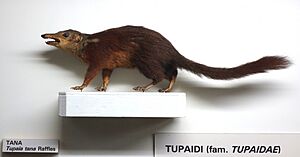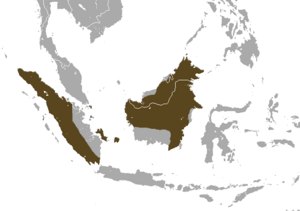Large treeshrew facts for kids
Quick facts for kids Large treeshrew |
|
|---|---|
 |
|
| Conservation status | |
| Scientific classification | |
| Genus: |
Tupaia
|
| Species: |
tana
|
 |
|
| Large treeshrew range | |
The large treeshrew (also known as Tupaia tana) is a small mammal that looks a bit like a squirrel. It belongs to a group of animals called treeshrews. You can find these treeshrews living in the wild on the islands of Sumatra and Borneo, as well as some smaller islands nearby.
Contents
Where Large Treeshrews Live
Large treeshrews spend most of their time on the ground. They are known for living mainly on the forest floor. This is where they look for most of their food. Even though they are mostly on the ground, they also spend some time climbing in trees.
These treeshrews are found most often in thick, green tropical rainforests. You can also spot them in swampy forests and forests that are growing back after being cut down. Large treeshrews help their forest home by spreading seeds. This helps new plants grow.
However, life in the forest can be dangerous for them. Many animals hunt large treeshrews. Some of their predators include the marbled cat, the leopard, and the clouded leopard.
What Large Treeshrews Look Like
The large treeshrew is a bit bigger than the common treeshrew. Its fur on its back is a reddish-brown color. This color gets darker, almost black, towards its rear end.
It has a black stripe that runs down its back. This stripe starts at its neck and goes about halfway down its body. It then fades into the darker fur.
Here are some typical body measurements for this animal:
- Head and body length: 165–321 mm (6.5–12.6 in)
- Tail length: 130–220 mm (5.1–8.7 in)
- Hind foot length: 43–57 mm (1.7–2.2 in)
- Weight: 154–305 g (5.4–10.8 oz)
The large treeshrew has a long snout, which is the front part of its face. From the middle of its eye to the tip of its nose, the distance is usually more than 37 mm (1.5 in) in adult treeshrews.
These animals have very good hearing. They also have large eyes that help them see well in the dark. However, their eyesight during the day is not as good.
What Large Treeshrews Eat
Large treeshrews have a varied diet. They mainly eat earthworms and different kinds of arthropods. Arthropods are creatures like insects and spiders.
Some of their favorite arthropods include centipedes, millipedes, and beetle larvae. They also eat some fruit. Less common foods they might eat are ants, beetles, spiders, cockroaches, and crickets.
Reproduction and Life Cycle
Large treeshrews usually become old enough to have babies when they are about one year old. This applies to both males and females.
When a female large treeshrew gives birth, she almost always has two young. These babies are born helpless and need a lot of care from their mother. If there isn't enough food or if their home isn't very good, females might have fewer babies.


